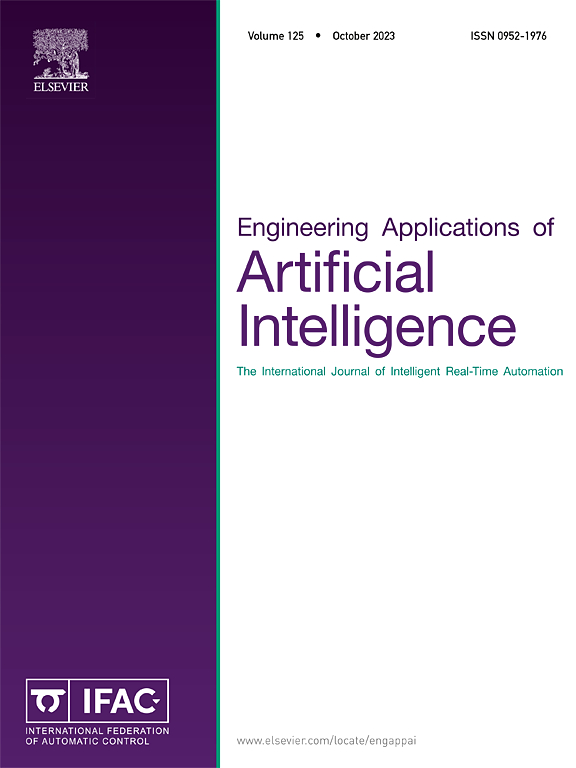叶片病害区域检测与分割的统一多任务模型
IF 7.5
2区 计算机科学
Q1 AUTOMATION & CONTROL SYSTEMS
Engineering Applications of Artificial Intelligence
Pub Date : 2025-07-26
DOI:10.1016/j.engappai.2025.111853
引用次数: 0
摘要
农作物病害对农业生产构成挑战。确定疾病点、评估感染区域和衡量感染严重程度是有效控制疾病的关键。然而,病变的变化、模糊的边界和小而密集的病变使精确的检测和分割变得困难。提出了一种基于检测变压器(DETR)的端到端统一多任务模型,用于叶片病区检测与分割。它集成了卷积神经网络(cnn)和Transformer,使用上下文转换网络(CoTNet)进行特征提取,并结合了盒注意和参考窗口更新等创新机制。此外,我们还设计了一种新的实例分割头。这个头有效地解决了微小病斑和叶表面之间的错误分类问题。实验表明,该模型达到了平均精度(AP)。4种疾病的检测召回率达到76.8%,分割召回率达到73.4%,边界盒(APbox)的平均精度为73.9%,口罩(APmask)的平均精度为68.2%,小尺寸边界盒(APsbox)的平均精度为29.0%,小尺寸口罩(APsmask)的平均精度为27.1%。与此同时。该模型架构具有4010万(m)参数和每秒169千兆浮点运算(GFLOP)的计算复杂度,证明了其实际可行性。疾病分级准确率达92.07%。在本研究中,实现了一个基于人工智能(AI)的模型,以解决叶片病害检测和分割的挑战。该模型集成了目标检测和实例分割任务,可用于准确识别和分级叶片病害,为农业病害防治策略提供支持。本文章由计算机程序翻译,如有差异,请以英文原文为准。
A unified multi-task model for leaf disease region detection and segmentation
Crop diseases challenge agricultural production. Pinpointing disease spots, assessing infection areas, and gauging infection severity are crucial for effective disease control. However, lesion variations, blurred boundaries, and small, dense lesions make precise detection and segmentation difficult. This paper presents an end-to-end unified multi-task model based on Detection Transformer (DETR) for leaf disease region detection and segmentation. It integrates Convolutional Neural Networks (CNNs) and Transformer, uses the Contextual Transformer Network (CoTNet) for feature extraction, and incorporates innovative mechanisms like box-attention and reference window update. Additionally, we have devised a novel instance segmentation head. This head effectively addresses the misclassification issue between minute disease spots and leaf surfaces. Experiments show the model achieves Average Precision (). The Average Precision of Bounding Box () of 73.9 %, the Average Precision of Mask () of 68.2 %, the Average Precision of Small-sized Bounding Box () of 29.0 %, and the Average Precision of Small-sized Mask () of 27.1 % for four diseases, with detection recall reaching 76.8 % and segmentation recall reaching 73.4 %. Meanwhile. The model architecture demonstrates practical feasibility with 40.1 million (m) parameters and 169 Giga Floating-point Operations Per Second (GFLOP) computational complexity. The accuracy of disease grading reaches 92.07 %. In this study, a model based on Artificial Intelligence (AI) was implemented to address the challenges in leaf disease detection and segmentation. The proposed model, which integrates object detection and instance segmentation tasks, can be applied to accurately identify and grade leaf diseases, providing support for disease control strategies in agriculture.
求助全文
通过发布文献求助,成功后即可免费获取论文全文。
去求助
来源期刊

Engineering Applications of Artificial Intelligence
工程技术-工程:电子与电气
CiteScore
9.60
自引率
10.00%
发文量
505
审稿时长
68 days
期刊介绍:
Artificial Intelligence (AI) is pivotal in driving the fourth industrial revolution, witnessing remarkable advancements across various machine learning methodologies. AI techniques have become indispensable tools for practicing engineers, enabling them to tackle previously insurmountable challenges. Engineering Applications of Artificial Intelligence serves as a global platform for the swift dissemination of research elucidating the practical application of AI methods across all engineering disciplines. Submitted papers are expected to present novel aspects of AI utilized in real-world engineering applications, validated using publicly available datasets to ensure the replicability of research outcomes. Join us in exploring the transformative potential of AI in engineering.
 求助内容:
求助内容: 应助结果提醒方式:
应助结果提醒方式:


